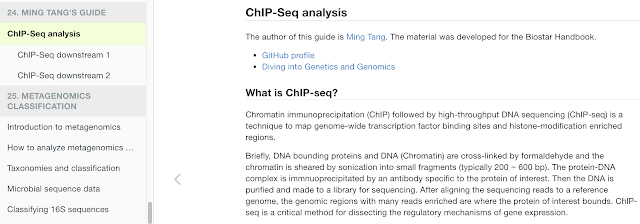Last year, I wrote:
For the coming 2017, I should be:
1. busy with Phoebe.
2. writing 1-2 papers.
3. writing a book chapter on ChIP-seq for the biostar handbook. It should come out in the mid of 2017.
3. writing a small R package for practice.
4. learning a piano song.
Looking back, it seems I only accomplished 1 and 3 :) I do have two first-author papers in writing-stage, but I have not finished them yet. I wish I could get them out in 2018.
The book chapter on ChIP-seq was published here. If you want a PDF of my chapter, you can download from https://drive.google.com/open?id=1UxB0uhsoWlPvymukP3em8v4vBDI-CKwK
I still have not got a chance to write an R package, which is on my list for long. The coming 2018 is a good time for me to get my hands wet. Our epigenomic project was selected by the Data Science Road-Trip program !! I received the confirmation in the end of 2017. I look forward to learn more R and machine learning for 2 weeks. And the plan is to turn the work into an R package. Many thanks to @JasonWilliamsNY, I saw this opportunity from his tweet. The development of R package is becoming easier with hadley wickham's work usethis and many others.
I failed #4 totally...I did not get any time to practice the piano. My wife is occupied by Phoebe and does not have time to teach me either.
I have some other achievements that I think I need to celebrate though:)
I am proud to say that I am an official instructor for Data Carpentry! I went to the instructor training in UC Davis hosted by Dr.Titus Brown. I am excited to be part of this welcoming community.
I am also excited to be a Genomics Advisory committee member of Data Carpentry and a maintainer of the Wrangling Genomics course materials.
I got to practice some teaching skills learned from the instructor training in a ChIP-seq lab, which is part of the GS01 1143 Introduction to Bioinformatics course.
Together with Dr.Kunal Rai, I authored a book chapter on Computational Analysis of Epigenetic Modifications in Melanoma. It should be out in 2018.
The other thing I want to mention is that I wrote several NGS processing workflows using Snakemake, a python extension. It was my first time to write something seriously using python and I like it a lot.
The most complex workflow I have written is the mutation calling pipeline (find it here).
I follow GATK best practices and incorporate two somatic callers: mutect and lancet. In my current lab of Dr.Jianjun Zhang and Dr.Andrew Futreal, I deal with multi-region or longitudinal tumor samples from the same patient. In the pipeline, I implemented copy-number analysis and pyclone clonal architecture analysis. The Snakefile is over 1000 lines, I need to think about modularizing it.
Of course, my ChIP-seq snakemake processing pipeline is used to uniformly process thousands of data sets generated in Dr.Kunal Rai's lab. I am happy that many wet lab members are learning computation and are using it by themselves.
In addition to DNA-seq and ChIP-seq. I developed several other workflows:
RNA-seq
ATAC-seq
RRBSeq
I will need to better document all the workflows.
For the coming 2018:
2. That does not mean I will spend less time on teaching. In fact, I plan to bring at least one Data Carpentry workshop down to Genomic Medicine department in MD Anderson Cancer Center.
3. Finish that R package of course!
4. I am expecting my second child Noah in April 2018 ( We survived Hurricane Harvey 2017!!). I know it will be even busier with 2 kids :) I love my first kid Phoebe, she is now 17 months. The joy she has brought to me is not exchangeable with anything else. I endeavor to be a better researcher, but first I need to be a better husband and father.
Looking forward to a brand new 2018! Good luck everyone.


can you email me your chip-seq pdf? thanks! let me know how i should send you my email address in private.
ReplyDeleteyou can download here https://drive.google.com/open?id=1UxB0uhsoWlPvymukP3em8v4vBDI-CKwK
Delete